Retention of Moisture in Soil With Organic Amendments Cultivated with Amaranthus Hypochondriacus
Aquino Edith Gabriela 1 * , Dionicio Juárez 2 , Fernando Hernández 3 , José Cinco Patrón 2 and Miguel Ãngel Albores 4
1
Posgrado en Manejo Sostenible de Agroecosistemas
2
Centro de AgroecologÃa,
Instituto de Ciencias (CENAGRO-ICUAP)
3
Laboratorio de QuÃmica Ambiental,
Centro De QuÃmica,
Instituto de Ciencias
4
Centro Interamericano de Recursos del Agua (CIRA),
UAEM,
Toluca,
Estado de México
Corresponding author Email: egaf20@gmail.com
DOI: http://dx.doi.org/10.12944/CWE.11.2.03
A field experiment was conducted to investigate the effect of different organic amendments (corn stubble and amaranth stubble, goat manure, compost, and green fertilizer (Medicago sativa)), alone and in combination with a hydrogel, into the moisture retention of the soil, deposited over the soil surface and mixed with surface soil, making a total of 14 treatments. To test their effects, the amaranth plants (Amaranthus hypochondriacus L.), were subjected to different periods of drought. Considered as tolerant to the drought and estimating their vegetative development for leaf production, the treatments were proven under random arrays with 10 repetitions. The agronomic variables considered were, height and survival of the plants as well as their stem diameter. The amendments do not present significant effects on the retention of moisture at 5 cm soil depth. In relation to the vegetative parameters, the hydrogel application demonstrates significant statistical differences for the survey of the plants (p>0.05). The amendments evaluated under the organic padding conditions with corn stubble, in conjunction with the green Medicago sativa fertilizer and the corn stubble mixed with soil, were the treatments which present the best results, in both stem diameter and plant height (Tukey`s test, α=0.05). All the variables show significant statistical differences according to the drought periods of between 0 and 15 days, applied to the different essays.
Copy the following to cite this article:
Gabriela A. E, Juarez D, Hernández F, Patron J. C, Albores M. A. Retention of Moisture in Soil With Organic Amendments Cultivated with Amaranthus Hypochondriacus. Curr World Environ 2016;11(2) DOI:http://dx.doi.org/10.12944/CWE.11.2.03
Copy the following to cite this URL:
Gabriela A. E, Juarez D, Hernández F, Patron J. C, Albores M. A. Retention of Moisture in Soil With Organic Amendments Cultivated with Amaranthus Hypochondriacus. Curr World Environ 2016;11(2). Available from: http://www.cwejournal.org/?p=14215
Download article (pdf)
Citation Manager
Publish History
Select type of program for download
| Endnote EndNote format (Mac & Win) | |
| Reference Manager Ris format (Win only) | |
| Procite Ris format (Win only) | |
| Medlars Format | |
| RefWorks Format RefWorks format (Mac & Win) | |
| BibTex Format BibTex format (Mac & Win) |
Article Publishing History
| Received: | 2015-10-02 |
|---|---|
| Accepted: | 2016-05-26 |
Introduction
The water balance in the field is strongly related to hydrological processes over the surface soils, which are actually affected by the global climate change. Accordingly with the UNESCO, the hydric resources and the soil degradation are the principal factor that threatens the sustainability of the agricultural lands of Latin America.1
In the case of temporal agriculture, water is the most necessary and limiting factor for the growth and production of crops, depending on the rain-season length and the availability of water in the soil. The water storage capacity of the soil is determined by the effective depth of the roots and the water retention properties of the soil.2
Currently, the application of the organic amendments (manure, compost, green fertilizer and crops residues) is becoming increasingly more common, the objective being to improve the fertility conditions of the soil, increase the availability of nutrients for the plants, as well as their moisture soil retention capacity .3-6 In semi-arid regions, the supply of organic material for soils’ moisture retention can be essential for the maintenance of their productivity.7
Amaranth is an herbaceous plant that produces lots of cereal-type food grain. The cultivation of amaranth has been an alternative for dry areas due to its great adaptability to rain fed conditions. However, long periods of drought can affect the development of these plants.
For that reason, it is important to evaluate the moisture retention capacity of the different amendments to guarantee the development and the goal production of the crop. The objective of the present research was to evaluate the effects of the implementation of a variety of organic amendments in relation to the moisture retention of the soil, alone and in combination with a hydrogel, in order to maintain an acceptable level of moisture for the root system of the amaranth plant (Amaranthus hypochondriacus L.), with the purpose of achieving its vegetative development, due to its dual function of being consumed as a grain and also as a vegetable (the foliar part).
Materials and Methods
The experimental site is located at the Water Museum, municipality of San Gabriel Chilac, Puebla, Mexico (18°18′57″ N and 97°21′34″ O), at 1256 m of altitude. The weather of the zone is semi-arid and warm, with an annual average precipitation of 456 mm and a potential evapotranspiration of 831 mm. The site presents a large period without rain between the months of December and May. The soil characteristics that influence the moisture retention capacity and the development of the plants are demonstrated in Table 1.
Table 1: Physical and chemical characteristics of the soil of the experimental plot
|
Variable |
Unidad |
Valor |
|
pH |
7.8 |
|
|
Organic matter (OM) |
% |
4.9 |
|
Field capacity (FC) |
% moisture |
36.6 |
|
Wilting point (WP) |
% moisture |
25.7 |
|
Bulk density |
g cm-3 |
1.08 |
|
Sand |
% |
38.7 |
|
Silt |
% |
41.8 |
|
Clay |
% |
19.5 |
The plot used for the experiment is located over the Leptosol soil, in terrace conditions, although the substrate in which the roots develop is filled with alluvium material, which has been cultivated with Amaranth under the concept of organic agriculture. An organic amendment characterization was conducted for field capacity and permanent wilting point variables, in the Physical Soil Laboratory of the Post Graduate College (Table 2), Montecinos Campus; likewise the moisture retention curves were calculated (Figure 1).
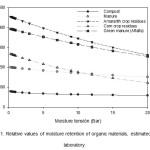 |
|
Table 2: Physicochemical properties of the organic materials
|
Material |
pH |
%OM |
FC |
WP |
|
Compost |
7.9 |
43.4 |
79.2 |
61.1 |
|
Corn stubble (Zea mays) |
4.8 |
92.8 |
267.3 |
146.3 |
|
Amaranth stubble |
6.3 |
86.7 |
454.3 |
300.0 |
|
Goat manure |
8.4 |
65.3 |
199.9 |
160.5 |
|
Alfalfa (Medicago sativa) as green fertilizer |
7.4 |
83 |
393.3 |
282.9 |
Fourteen treatments were conducted (Table 3), with the exception of the residual treatment of the corn crop in an organic mulch form (OM). The mixture of the organic amendments with the soil were incorporated into it at a depth of 10 cm, at a rate of 4.5 Kg m-2, considering Huerta’s et al.,8 recommendations as a reference. Huerta used Mucuna pruriens in order to achieve a medium where the earthworm finds ideal living conditions, which in the present study will be related to an acceptable moisture conformation.
Table 3: Treatments evaluated in field
|
Code |
Treatment |
|
S-CM |
Compost goat manure (Capra hircus) with remains of plants |
|
S-MR |
Corn stubble (Zea mays) |
|
S-AR |
Amaranth stubble (Amaranthus hypochondriacus) |
|
S-OM |
Corn stubble as organic mulch |
|
S-GM |
Goat manure |
|
S-GA |
Alfalfa (Medicago sativa) as green fertilizer |
|
C |
Soil |
|
H-CM |
Hydrogel + Compost goat manure (Capra hircus) with remains of plants |
|
H-MR |
Hydrogel + Corn stubble (Zea mays) |
|
H-AR |
Hydrogel + Amaranth stubble (Amaranthus hypochondriacus) |
|
H-OM |
Hydrogel + Corn stubble as organic mulch |
|
H-GM |
Hydrogel + Goat manure |
|
H-GA |
Hydrogel + Alfalfa (Medicago sativa) as green fertilizer |
|
H |
Hydrogel applied directly to soil |
Each experimental unit was of 1 m2, of circular form, separated by one meter of distance. The hydrogel employed is a commercial product with a capacity to retain water up to 150 times its own weight. This material was previously hydrated and applied during the transplanting process.
Five Amaranth seedlings from a local nursery, all being 20 days old, were transplanted into each experimental unit. The experiment was a complete random array, with 10 repetitions, each of which at the beginning was subjected to constant homogeneous irrigation (each third day) at the beginning, with the objective to support both the plants’ rehabilitation and rooting.
Two repetitions were selected 60 days later, continuing with an uninterrupted irrigation. The irrigation was renewed for 2 additional repetitions at 5, 10 and 15 days later, concluding 60 days and 2 hours after the normal irrigation. Samples were taken from the soil for later measurement of the moisture in the laboratory, via the gravimetric method. The soil was dried inside a drying oven at 105 °C until a constant weight was achieved. The application of Equation 1, was implemented

5 days before the renewal of the irrigation of the subsequent 2 repetitions. Another sample was taken from the soil for the determination of the loss moisture after 5 days with normal irrigation. That procedure was repeated 10 and 15 days later, with a selected repetition for renewal of irrigation. The soil samples were taken at a depth of 5 and 10 cm, covering a period between the 14th and 29th of April of 2014.
On day 80 of the experiment, data was gathered from the surviving plants and their parameters of height and stem diameter, for each experimental unit.
At the end of the harvest, the dry material of the aerial part of the plants was calculated by the gravimetric method, using a drying oven at 70 °C until reaching the constant weight; the soil moisture was analyzed at depths of 5-10 cm, 10-20 cm and 20-30 cm per each treatment. At the middle of the drought period induced on the plants, the environmental parameters of: temperature, humidity (hygrometer traceable™), solar radiation (Luxmeter HI97500, HANNA) and soil temperature were measured, during 24 hours.
Statistical Analysis
From the soil humidity percentage data during the induced drought period, taken at 0, 5, 10 and 15 days, the slope model of moisture loss versus time, was conducted by linear regression, and subsequently adjusted to a binomial method. The purpose of the procedure was to reconstruct the behavior of the moisture retention curves of each treatment in field. The data obtained was analyzed using two-way ANOVA, a pre-test of homogeneity of variance. The averages of the treatments were compared by the Tukey's test at a level of significance of 0.05.9 The data was processed via the statistical software of Statgraphics.10
Results
Moisture Retention in Induced Drought
The record of the soil’s holding capacity of moisture of tested treatments is shown in Figure 2 and Figure 3. Said figures distinguish moisture to a depth of between 5 and 10 cm, in which all responded similarly.
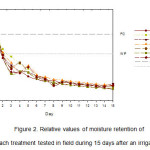 |
|
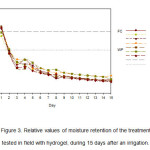 |
|
Humidity retention at the end of the experiment
The Figure 4 is a representation of the contents of final moisture during a testing period, into depths of 5-10, 10-20 and 20-30 cm, according to the applied treatment. The treatment which contained the highest percentage of moisture at a depth of 5-10 cm, as well as from 10-20 cm, corresponds to the Amaranth stubble with hydrogel (H-AR). On the other hand, at a depth of 20-30 cm, the compost, the corn crop residue, the organic padding and the hydrogel/manure mixture demonstrated the highest moisture content.
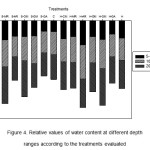 |
|
Drought induced effects on vegetative development
The use of hydrogel demonstrated significant differences (F (1,66)=4.22,p<0.04) on the survival of plants, especially when it was present in greater quantities in the treatments (Table 4). The presence of hydrogel seems to have no effect on the variables of stem diameter and plant height, F (1,66)=3.59, p<0.06 and F (1,66)=3.19, p<0.07, respectively.
Table 4: Effects of treatments on the variables: number of surviving plants, stem diameter and plant height.
|
Factor |
Number of surviving plants |
Stem diameter (cm) |
Plant height (cm) |
|||
|
Hydrogel |
||||||
|
With hydrogel |
6.4 ±0.1 |
a |
n.s. |
n.s. |
||
|
Without hydrogel |
6.7 ±0.1 |
b |
n.s. |
n.s. |
||
|
Organic material |
||||||
|
CM |
6.3 ±0.2 |
ab |
19.4 ±0.7 |
abc |
61.7 ±2.5 |
ab |
|
MR |
6.7 ±0.2 |
b |
22.3 ±0.7 |
cd |
69.2 ±2.5 |
bc |
|
AR |
7.9 ±0.2 |
c |
20.0 ±0.7 |
abc |
62.0 ±2.5 |
ab |
|
OM |
6.6 ±0.2 |
b |
23.0 ±0.7 |
d |
73.1 ±2.5 |
c |
|
GM |
5.7 ±0.2 |
a |
19.0 ±0.7 |
ab |
61.2 ±2.5 |
ab |
|
GA |
6.8 ±0.2 |
b |
22.0 ±0.7 |
bcd |
66.9 ±2.5 |
abc |
|
C |
6.3 ±0.2 |
ab |
18.9 ±0.7 |
a |
58.6 ±2.5 |
a |
|
Drought-induced |
||||||
|
0 days |
6.9 ±0.2 |
b |
22.7 ±0.6 |
c |
70.9 ±2.0 |
b |
|
5 days |
6.6 ±0.2 |
ab |
21.4 ±0.6 |
bc |
71.5 ±2.0 |
b |
|
10 days |
6.6 ±0.1 |
ab |
19.8 ±0.6 |
ab |
60.9 ±1.9 |
a |
|
15 days |
6.3 ±0.1 |
a |
18.6 ±0.4 |
a |
55.5 ±1.5 |
a |
Results in the same row with the same superscript were not significantly different (p < 0.05). n.s = no significant differences.
Differences in the variables were found depending upon the type of organic amendment employed: survival of the plants (F (6,66)=13.07,p<0.0), height (F (6,66)= 4.33,p<0.0) and stem diameter (F (6,66)= 12.2,p<0.0). In the case of the number of plants, the residues of Amaranth show the greatest number of plants per experimental unit, while the treatments with organic padding, green fertilizer (Medicago sativa) and the corn residue, demonstrate favorable results concerning stem diameter and plant height.
Table 4 shows a decrease in the development and growth of the Amaranth plants during a longer drought period. The lack of irrigation during 5 days, affects 6% of stem growth; 10 days, 13% and 15 days, 18% respectively. While the height of the Amaranth plant does not present any adverse effects at the 5-day drought point, the negative effects reach 14% and 22% at the 10- and 15-day drought points, respectively. It is important to highlight that in the field, some plants which were subject to the 15-day drought period were not able to recover their acceptable vegetative condition in order to harvest their leaves.
It is worth noting that the interaction of the hydrogel with the type of organic amendment has a significant favorable effect on the survival of the plants (F (6,66) = 3.18, p<0.0). This is also the case for the interaction of the organic amendment with the drought periods (days): plant survival (F (18,66)= 5.02, p<0.0), height (F (18,66)=4.09, p<0.0) and stem diameter (F (18,66)= 2.15, p<0.0).
The results of the variables of total dry matter are shown in Table 5. Significant statistical differences were obtained between the various periods of drought (F (3,18)=4.68, p<0.01).The treatments applied with compost, manure and the control have the lowest weight of total dry matter. The lack of water on crops causes effects on the plants. It can be observed how a mayor hydric stress on the plants diminished the production of dry matter. The average quantity of the dry matter for the units which did not experience drought throughout the crop cycle was 1.0 ±0.07 kg, while that the plants which are denied irrigation for 15 days demonstrate an average of 0.6 ±0.07.1 kg.
Table 5: Total dry matter according to periods of drought-induced
|
Period of drought-induced (days) |
Total dry matter (Kg) |
|
|
0 |
1.0 ±0.07 |
b |
|
5 |
0.9 ±0.07 |
ab |
|
10 |
0.8 ±0.07 |
ab |
|
15 |
0.6 ±0.07 |
a |
Results in the same row with the same superscript were not significantly different (p < 0.05).
Likewise, the type of organic amendment had a significant effect on the production of the dry matter (F (6,18)= 7.82, p<0.0). Adding the corn stubble to the treatment increased production of dry matter (1.3±0.1) and the control which presents the lowest production (0.52±0.1)
Discussion
According to the moisture retention curves performed in the laboratory, the residues of Amaranth and green alfalfa are the most promising amendments for the support of growing plants, even 5 times greater than compost. During the observation of the ranges of available moisture (amount of water between FC and WP), the greatest values are (in order of importance): Amaranth residues (154.3%), corn residues (121%) and green alfalfa (110.4%); whereas the lowest are: manure (39.4%), compost (18.1%) and lastly, the soil alone or the control (10.9%).
A variety of records have mentioned that organic amendments decrease apparent density, increase porosity and promote aggregate formation. 11 These effects in turn possess positive repercussions on moisture retention. No convincing effects are derived from this experiment relative to soil moisture retention with the application of the organic amendments. This lack of favorable effects could possibly be caused by a pre-existing positive response for the 4.9 % of OM which is contained in the soil, i.e. 327 Kg of OM m-2 and 30 cm of depth of the aerated soil layer, when the applications only reaching 4.5 Kg m-2, 1.4% more, but without achieving its incorporation into the soil due that the amendments, with the exception of the compost and the manure, which were similar to crop residue. Also, Barzegar does not report changes in the content of soil moisture at lower potentials (<100 KPa), according to the rate and type of organic matter. 7
Regarding the dosage, González et al. [12] a large percentage of soil moisture is obtained with a treatment of 60 t ha-1 of manure (65% of humidity), significantly surpassing chemical fertilizer (58.29%) and the control (53.76%). López
et al.,3 found that the application of 40 t ha-1 and 60 t ha-1 of bovine manure was the treatment which most retains and preserves the moisture throughout time. Similar results were reported by Salazar et al.,. 13 One study conducted in México with pepper (Capsicum annuum L.), using three doses of compost as a treatment concludes that the higher the amount of compost, the lower the level of evapotranspiration. This conclusion coincides with the greater moisture retention capacity of the different treatments14 It is worth mentioning that the dosage used in the present experiment (45 t h-1) could result barely sustainable, principally because a dry zone does not contain abundant quantities of organic materials.
The positive effect of the hydrogel usage for the plant survival and growth of the plants has been reported in various studies.15-17 However, the experiment in field did not report significant statistical differences regarding the moisture content of the soil. This result could be due to the depth of the sampling, which was always around midday.
The effects on the plants are evident during the vegetative development of the amaranth, on the variables of the plants’ height and stem diameter. This coincides with Esqueda, who found that the sequence with higher levels of moisture presents the greatest percentage of emergence and survival in different types of grains in three types of soils.18 In this case, crop residue could be considered as the best amendments, especially corn, which functions both mixed with the soil - corn stubble (MR) and with organic mulch (OM). Nevertheless, this effect is noteworthy because it also can be related to the soil buffer capacity of pH of 7.8, whereas the corn residue’s pH of 4.8 would favor better nutrient absorption from the soil and would permit an increase in plant growth.
Although Amaranth is considered to be a drought tolerant species, an acceptable limit of lack of moisture must be present. The optimal thermal conditions are from16 to 24 °C and between 800 and 1200 mm of rain precipitation.19 In the study site, the daily fluctuations provide real information of the environment and the soil plant growth due to higher temperatures and lower than recommended precipitation levels. Figure 5 shows the variations of those parameters mentioned during 24 hours, registered at the midpoint of the induced drought period. The maximum ambient temperature was 42.7 °C, at 16:30 hours, whereas the obtained values from the soil between 10 and 15 cm of depth reached a maximum of 32.3°C, between 17:30 and 20:30 hours. The heating process of the environment and the soil was caused by at least 3 previous hours of sunlight, whose maximum radiation level was at 13:30 hours (Figure 6). Although variations of soil temperature (23.83 - 32.33 °C) exist, this medium continues to act as a buffer for the plant roots.
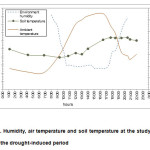 |
|
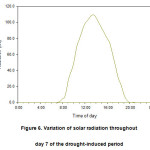 |
|
With the measurements of the temperature and humidity, the study site could be considered as a hostile environment for the Amaranth plants, because it suppresses the effects of moisture retention, particularly within the first 10 to 15 cm of depth, despite the rich texture of the site’s soil that could favor moisture retention. Nevertheless, local agriculturalists still prefer to plant this species due to the reality that other plant species can scarcely survive nor thrive there. In addition, these farmers are only able to implement auxiliary irrigation techniques due to the limited availability of water in the region.
Conclusion
The application of hydrogel increases the post transplanting survival of the amaranth plants by 4.48%. The application of organic amendments improves plant survival up to 10.3%; 23.21% stem diameter and 25.79% plant height compared to soil without any application (control).
A 5-day drought affects 6% of stem growth of the Amaranth plant; 10 days, 13%; and 15 days, 18%; respectively. Plant height, in a 5-day drought, is not affected considerably, but after 10 days (14%) and 15 days (22%).
Acknowledgements
To the Agroecology Center of the Science Institute of the BUAP, for its support to conduct postgraduate studies as well as to the CONACyT for the scholarship for the realization of the present research, as a part of the obtaining of the Master's degree. The authors acknowledge the collaboration of the group of Alternativas y Procesos de Participación Social A.C, for its financial support for the project, including the authorization to use inclusive the usage of the productive plot. Also, the laboratory of Soil Physics of the Postgraduate College is acknowledged for its support with the soil analysis.
References
- UNESCO, 2005. Evaluación de Parámetros y Procesos Hidrológicos en el Suelo. Documentos Técnicos en Hidrología del PHI, número de serie 71. (Available in http://unesdoc.unesco.org/images/0013/001384/138406s.pdf)
- Manschadi, A. M., Christopher, J., deVoil, P., Hammer, G. L. The role of root architectural traits in adaptation of wheat to water-limited environments. Functional Plant Biology, 33, 823–837 (2006).
CrossRef - López-Martínez, J. D.; Díaz-Estrada, A.; Martínez-Rubín, E. and Valdez-Cepeda, R. D. Abonos orgánicos y su efecto en propiedades físicas y químicas del suelo y rendimiento en maíz. Terra Latinoamericana, 19, 293-299 (2001).
- Forero, F. E.; Fernández, J. P. and Álvarez-Herrera, J. G. Efecto de diferentes dosis de cachaza en el cultivo de maíz (Zea mays). Revista U.D.C.A Actualidad & Divulgación Científica, 13, 77-86 (2010).
- Arrieche, I. and Mora, O. Efecto de la aplicación de residuos orgánicos sobre el cultivo del maíz en suelos degradados del Estado Yaracuy, Venezuela. Bioagro, 17, 155-159 (2005).
- Radillo, F.; Aguilar, S.; Flores, M. and Martínez, J. Efecto de abonos orgánicos y fertilizantes inorgánicos en la producción de grano seco de maíz (Zea mays). Memorias del VII Congreso Nacional de Agricultura Sostenible. Agricultura Orgánica, 1-11 (2013).
- Barzegar, A. R.; Yousefi, A. and Daryashenas, A. The effect of addition of different amounts and types of organic materials on soil physical properties and yield of wheat. Plant and Soil, 247, 295–301(2002).
CrossRef - Huerta, E.; Fragoso, C. and Lavelle, P. Efecto de la aplicación de hojarasca de mucuna sobre densidad y biomasa de lombrices de tierra. Terra Latinoamericana, 23, 533-544 (2005).
- Zar, J. H.,Biostatistical analysis 5th Edition, Prentice Hall,Englewood Cliffs, NJ., 944 (2010).
- Statgraphics 2010. Statgraphics Centurion XVI User Manual. Stat Point Technologies, Inc. E. S. A., 305, (2010).
- Akanni, D. I. and Ojeniyi, S. O. Residual Effect of Goat and Poultry Manures on Soil Properties Nutrient Content and Yield of Amanranthus in Southwest Nigeria. Research Journal of Agronomy, 2, 44-47 (2008).
- González, J.; Fortis, M.; Orona, I.; Vázquez, C.; Omaña, J. and Molina, J. Estiércol de bovino y fertilización foliar en la producción de maíz forrajero. Memorias del VII Congreso Nacional de Agricultura Sostenible. Agricultura Orgánica, 165-179 (2013).
- Salazar-Sosa, E.; Trejo-Escareño, H. I.; Vázquez-Vázquez, C.; López-Martínez, J.D.; Fortis-Hernández, M.; Zuñiga-Tarango, R. and Amado-Álvarez, J. P. Distribución de nitrógeno disponible en suelo abonado con estiércol bovino en maíz forrajero. Terra Latinoamericana, 27, 373-382 (2009).
- Nieto-Garibay, A.; Murillo-Amador, B.; Troyo-Diéguez, E.; Larrinaga-Mayoral, J. A. and García, J. L. El uso de compostas como alternativa ecológica para la producción sostenible del Chile (capsicumannuum) en zonas áridas. Interciencia, 27, 417-421 (2002).
- Tittonell, P. A.; De Grazia, J. and Chiesa, A. Adición de polímeros superabsorbentes en el medio de crecimiento para la producción de plantines de pimiento. Horticultura Brasileira, 20, 641-645 (2002).
CrossRef - Chirino, E.; Vilagrosa, A. and Vallejo, V.R. Utilización de materiales hidro-absorbentes en el substrato de cultivo para reducir el estrés hídrico post-transplante en brinzales de Quercussuber. 5to Congreso Forestal Español. Sociedad Española de Ciencias Forestales, (2009).
- Nissen, J. and San Martín, K. Uso de poliacrilamidas y el riego en el manejo hídrico de lechugas (Lactuca sativa). Agro sur, 32, 1-12 (2004).
CrossRef - Esqueda, M. H.; Melgoza, A.; Sosa, M.; Carrillo, R. and Jiménez, J. Emergencia y sobrevivencia de gramíneas con diferentes secuencias de humedad/sequía en tres tipos de suelo. Técnica Pecuaria en México, 43, 101-115 (2005).
- Granados, R.; Reyna, T.; Fernández, Y. and Soria, J. Aptitud agroclimática en la Mesa Central de Guanajuato, México. Investigaciones geográficas (Mx), 54, 24-35 (2004).






